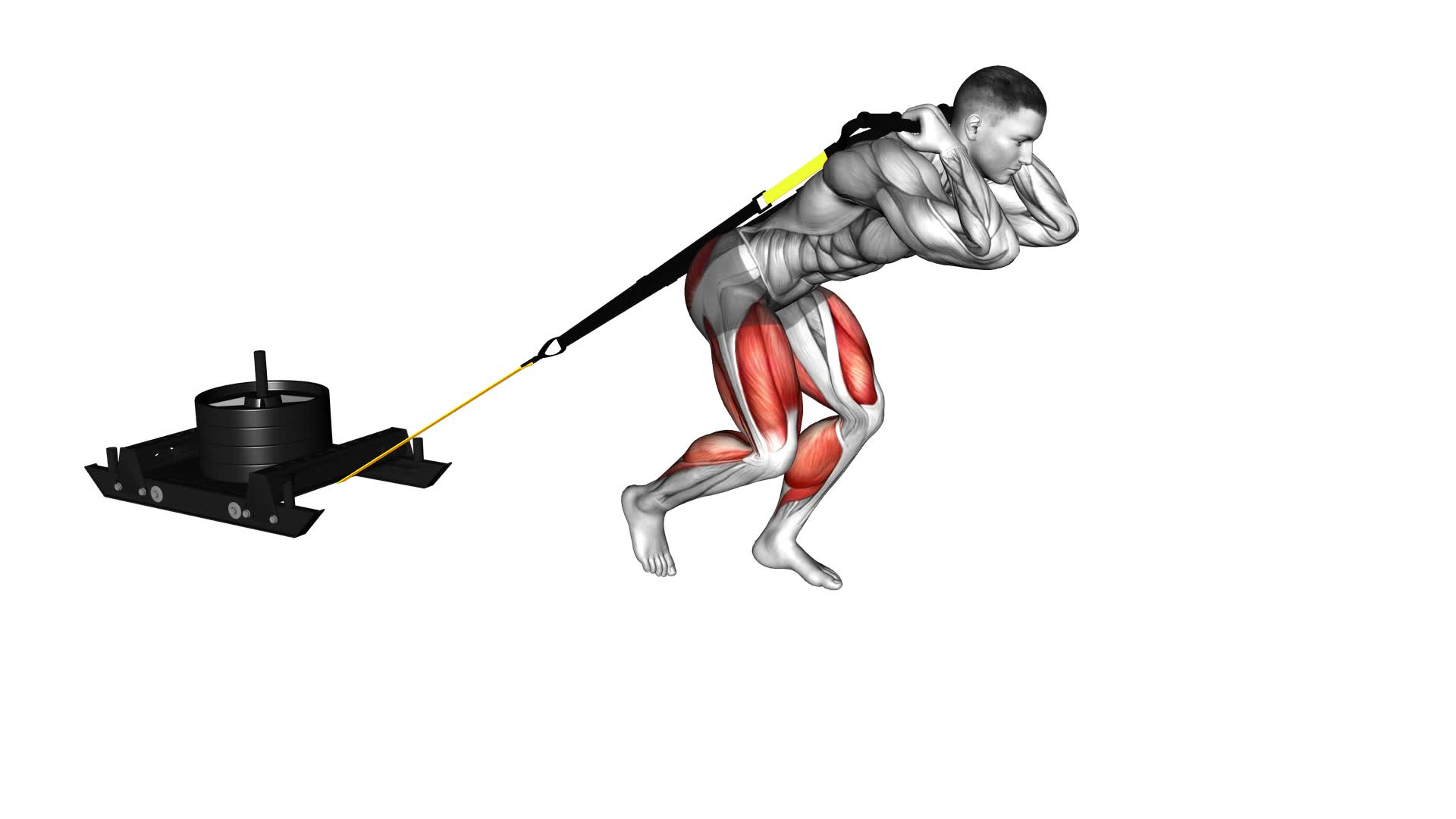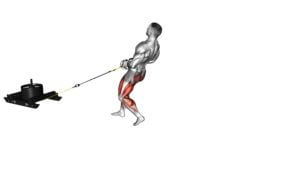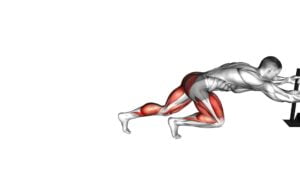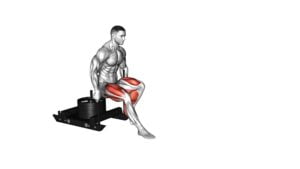Power Sled Drag – Video Exercise Guide & Tips

Are you looking to level up your workout routine? Get ready to discover the power of the sled drag!
Watch This Exercise Video
In this video exercise guide, we'll show you how to perform this challenging yet effective exercise. By using a sled and harness, you'll engage your entire body, building strength and endurance.
Whether you're a seasoned athlete or just starting out, our tips and techniques will help you maximize your workout. Get ready to push your limits with the power sled drag!
Key Takeaways
- Power sled drag improves speed and is a great addition to a strength training routine.
- It engages multiple muscle groups including quadriceps, hamstrings, glutes, and core.
- Power sled drag translates into improved speed and power in activities like sprinting or jumping.
- It is a low-impact exercise suitable for all fitness levels and improves cardiovascular endurance.
Benefits of Power Sled Drag
By performing power sled drags, you can experience a multitude of benefits for your overall strength and conditioning. This exercise is highly effective in improving speed and is a great addition to any strength training routine. When you perform power sled drags, you're engaging multiple muscle groups including your quadriceps, hamstrings, glutes, and core. This helps to build strength in these areas, which can then translate into improved speed and power in other activities such as sprinting or jumping.
Additionally, power sled drags are a low-impact exercise, making them suitable for individuals of all fitness levels. They provide a challenging workout without putting excessive stress on your joints. Incorporating power sled drags into your training regimen can also help to improve your overall cardiovascular endurance, as it's a demanding exercise that requires both strength and stamina.
Overall, power sled drags offer a unique and effective way to enhance your strength training and improve your speed.
Now, let's move on to discuss the equipment needed for power sled drag.
Equipment Needed for Power Sled Drag
To perform power sled drags, you'll need specific equipment. The most essential piece of equipment is the power sled itself. When choosing a power sled, it's important to consider your fitness level and goals. Power sleds come in various sizes and designs, so select one that suits your needs.
In addition to the power sled, you'll need a harness or straps to attach yourself to the sled. These harnesses should be sturdy and comfortable, as they'll bear the weight of the sled as you drag it. Make sure the harness fits securely and provides proper support.
When it comes to weight selection for power sled drags, start with a weight that challenges you but allows you to maintain good form and control. As you progress, you can gradually increase the weight. It's important not to overload the sled, as it can lead to injury.
Safety precautions are crucial when performing power sled drags. Always warm up properly before starting the exercise to prepare your muscles and joints. Maintain proper form throughout the movement, keeping your back straight and engaging your core. Start with shorter distances and gradually increase the distance as you become more comfortable with the exercise.
Proper Technique for Power Sled Drag
To perform the power sled drag with proper technique:
- Start by positioning your feet shoulder-width apart and facing forward. This will provide a stable base and allow for efficient force transfer.
- Engage your core muscles throughout the drag to maintain stability and protect your lower back.
Foot Positioning for Drag
Maintain a stable and balanced stance by placing your feet shoulder-width apart when performing the power sled drag. Proper foot placement is crucial for maximizing muscle activation and minimizing the risk of injury during this exercise.
By positioning your feet at shoulder-width apart, you create a solid base of support that allows you to generate force and propel the sled forward effectively. This wider stance also helps distribute the load evenly across your lower body, engaging multiple muscle groups simultaneously.
Additionally, keeping your feet parallel to each other ensures optimal alignment and prevents any unnecessary strain on the joints. Remember to maintain a slight bend in your knees and keep your weight evenly distributed throughout your feet for optimal stability and power transfer.
Core Engagement During Drag
Engage your core to maintain stability and power during the power sled drag. Proper core activation is crucial for maximizing muscle engagement and preventing injury.
Here's how to engage your core effectively during the drag:
- Start by standing tall and bracing your core muscles, including your abdominal muscles, obliques, and lower back.
- Imagine pulling your belly button towards your spine to activate your deep core muscles.
- Keep your core engaged throughout the entire movement, maintaining a strong and stable midsection.
By engaging your core during the power sled drag, you create a solid foundation for generating power and transferring force from your lower body to the sled. This helps to protect your spine and maintain proper alignment, allowing you to perform the exercise with optimal efficiency and effectiveness.
Variations and Progressions of Power Sled Drag
Try incorporating different variations and progressions of the power sled drag to maximize your training potential. By adding variety to your workouts, you can challenge your muscles in new ways and keep your training program exciting.
One variation of the power sled drag is the backward drag. Instead of moving forward, you'll pull the sled behind you. This variation targets your posterior chain, including your hamstrings, glutes, and lower back. It can help improve your acceleration and speed, making it a great addition to your training routine if you participate in sports that require quick bursts of speed.
Another variation is the lateral drag. Instead of moving straight ahead, you'll move laterally while dragging the sled. This variation targets your hip abductors and adductors, helping to improve your lateral movement and stability. It can be particularly beneficial for athletes who participate in sports such as basketball or soccer.
To progress your power sled drag, you can increase the weight on the sled. Start with a lighter load and gradually increase the weight over time as your strength improves. You can also try performing the exercise on an incline or decline to add an extra challenge to your workout.
Incorporating these variations and progressions into your power sled drag routine can help you continue to make gains in your training and reach your fitness goals. Remember to always use proper form and start with a weight that's appropriate for your current fitness level.
Common Mistakes to Avoid in Power Sled Drag
When performing the power sled drag, it's important to be aware of common mistakes to avoid in order to maximize the effectiveness of the exercise and prevent injury. Here are some common errors to watch out for:
- Using too much weight: One of the biggest mistakes people make is loading up the sled with too much weight. Using excessive weight can compromise your form and increase the risk of injury. Start with a manageable weight and gradually increase it as you get stronger.
- Incorrect body position: Maintaining the correct body position is crucial during the power sled drag. Avoid leaning too far forward or backward, as this can put strain on your lower back. Instead, maintain an upright posture with a slight forward lean and engage your core muscles.
- Neglecting proper foot placement: Another mistake to avoid is placing your feet too close together or too far apart. Your feet should be shoulder-width apart, providing a stable base of support. This will help you generate more power and maintain balance throughout the exercise.
By being mindful of these common mistakes, you can ensure that you're performing the power sled drag correctly and safely.
Now, let's move on to the next section, where we'll discuss some tips for maximizing your power sled drag workout.
Tips for Maximizing Your Power Sled Drag Workout
To maximize your power sled drag workout, focus on maintaining proper form and maximizing your power output. Proper form is essential to prevent injuries and ensure that you're targeting the correct muscles. Make sure to keep your back straight and engage your core throughout the exercise. This will help you generate maximum power and transfer it efficiently to the sled.
To maximize intensity, gradually increase the weight on the sled as you progress. Start with a weight that allows you to maintain proper form, but challenges you. As you become more comfortable, gradually add more weight to increase the intensity of your workout.
Breathing technique is also crucial during the power sled drag. Take deep breaths in through your nose and exhale forcefully through your mouth as you exert force to move the sled. This will help you maintain your energy and power throughout the exercise.
Remember to take breaks when needed, but try to keep them short to maintain the intensity of your workout. Rest for about 30 seconds to 1 minute between sets to allow your muscles to recover partially before going for the next round.
Incorporating these tips into your power sled drag workout will help you maximize your intensity and get the most out of your training session. Stay focused, push yourself, and enjoy the benefits of this challenging exercise.
Frequently Asked Questions
How Many Sets and Reps Should I Do When Performing Power Sled Drags?
When performing power sled drags, it's important to consider the number of sets and reps. The ideal set and rep range for power sled drags will depend on your fitness goals and current fitness level.
To benefit from incorporating power sled drags into your circuit training routine, aim for 3-4 sets of 8-12 reps. Adjust the resistance by adding weight plates to the sled, gradually increasing the load to challenge your muscles and maximize results.
Can Power Sled Drags Help Improve Speed and Agility?
Power sled drags can definitely help improve your speed and agility. By incorporating this exercise into your training routine, you'll see improvements in your acceleration and overall athletic performance.
The benefits of power sled drags include increased lower body strength, improved power generation, and enhanced explosiveness. This exercise targets key muscles involved in speed and agility, such as the glutes, hamstrings, and quadriceps.
Incorporating power sled drags into your workouts will take your athletic abilities to the next level.
Is Power Sled Drag Suitable for Beginners or Is It More Suitable for Advanced Athletes?
Power sled drag exercises can be suitable for both beginners and advanced athletes. If you're just starting out, there are modifications you can make to make the workout more manageable. As you progress, you can gradually increase the weight and intensity of the sled drag.
This exercise is great for building strength and power in your lower body, as well as improving overall conditioning. So don't worry, whether you're a beginner or advanced, power sled drags can benefit you.
Can Power Sled Drags Be Used as a Conditioning Exercise?
Power sled drags can definitely be used as a conditioning exercise. They're a great way to improve your cardiovascular fitness and build endurance. There are different variations of power sled drags that you can try, such as forward drags, backward drags, and lateral drags. These exercises target your lower body muscles, including your glutes, quadriceps, and hamstrings.
Incorporating power sled drags into your training routine can benefit athletes by enhancing their speed, explosiveness, and overall athletic performance.
Are There Any Specific Muscles Targeted During Power Sled Drags?
During power sled drags, several specific muscles are targeted, providing numerous benefits for athletes. The primary muscles engaged include the quadriceps, hamstrings, glutes, and calves. These muscles work together to generate power and force while dragging the sled.
Additionally, the upper body muscles, such as the core, back, and shoulders, are also activated to stabilize the body during the exercise.
Power sled drags not only improve overall strength and power, but also enhance speed, explosiveness, and conditioning, making them an excellent addition to any athlete's training routine.
Conclusion
In conclusion, the power sled drag is an effective exercise that offers numerous benefits, such as improving strength, power, and overall conditioning.
By using the proper technique and equipment, you can maximize the effectiveness of this exercise. Additionally, incorporating variations and progressions can help you continue challenging your muscles and making progress.
Avoiding common mistakes and following the provided tips will ensure a safe and effective power sled drag workout.
Start incorporating this exercise into your routine and experience the benefits for yourself.

Author
Years ago, the spark of my life’s passion ignited in my mind the moment I stepped into the local gym for the first time. The inaugural bead of perspiration, the initial endeavor, the very first surge of endorphins, and a sense of pride that washed over me post-workout marked the beginning of my deep-seated interest in strength sports, fitness, and sports nutrition. This very curiosity blossomed rapidly into a profound fascination, propelling me to earn a Master’s degree in Physical Education from the Academy of Physical Education in Krakow, followed by a Sports Manager diploma from the Jagiellonian University. My journey of growth led me to gain more specialized qualifications, such as being a certified personal trainer with a focus on sports dietetics, a lifeguard, and an instructor for wellness and corrective gymnastics. Theoretical knowledge paired seamlessly with practical experience, reinforcing my belief that the transformation of individuals under my guidance was also a reflection of my personal growth. This belief holds true even today. Each day, I strive to push the boundaries and explore new realms. These realms gently elevate me to greater heights. The unique combination of passion for my field and the continuous quest for growth fuels my drive to break new ground.







